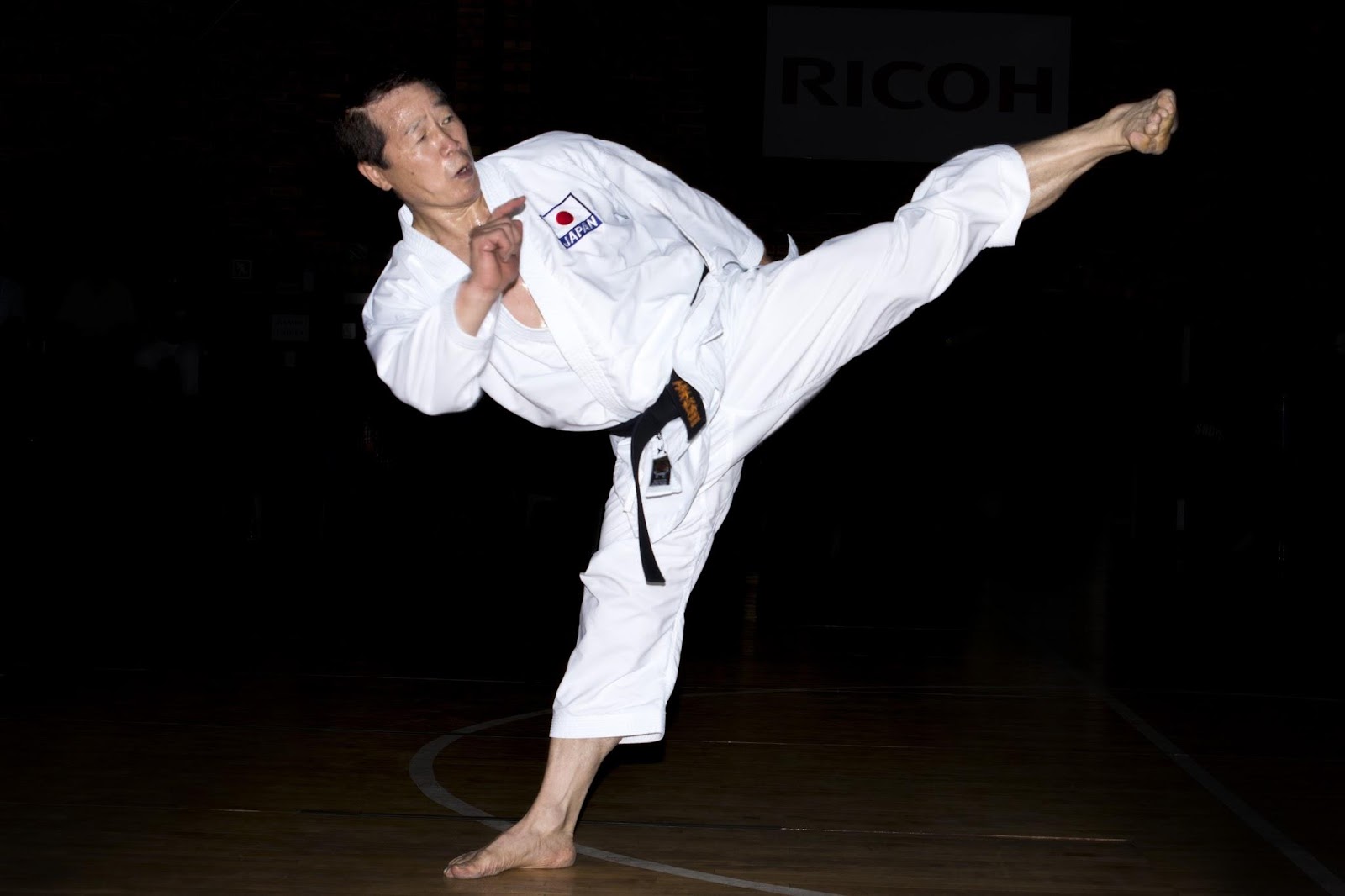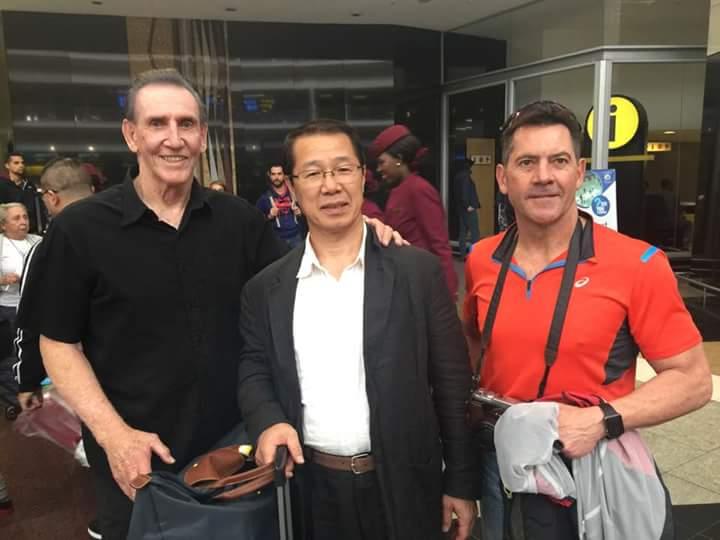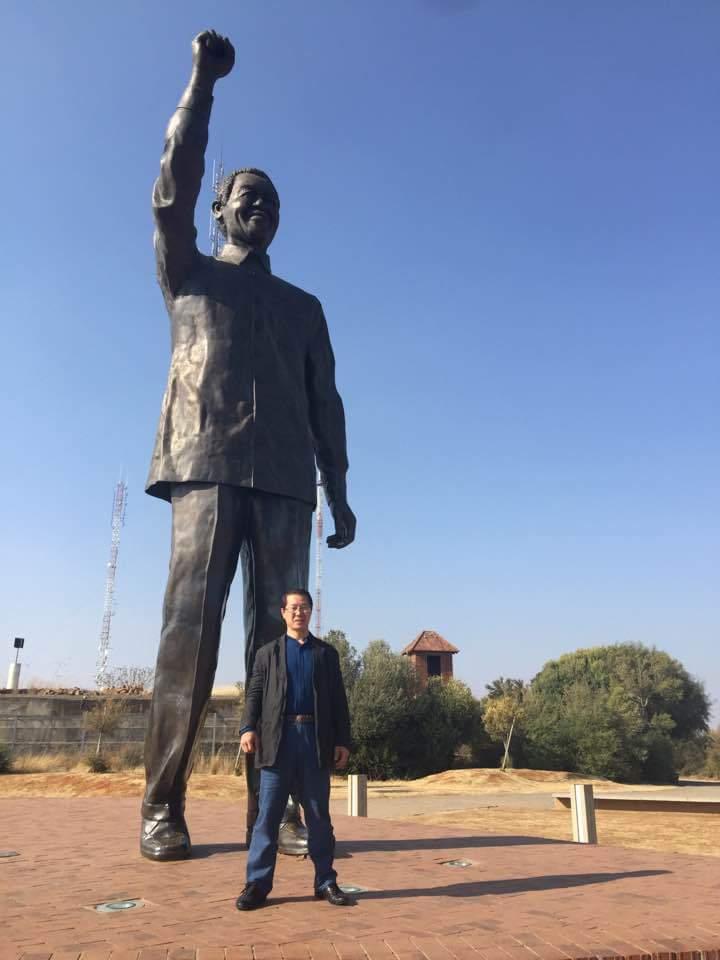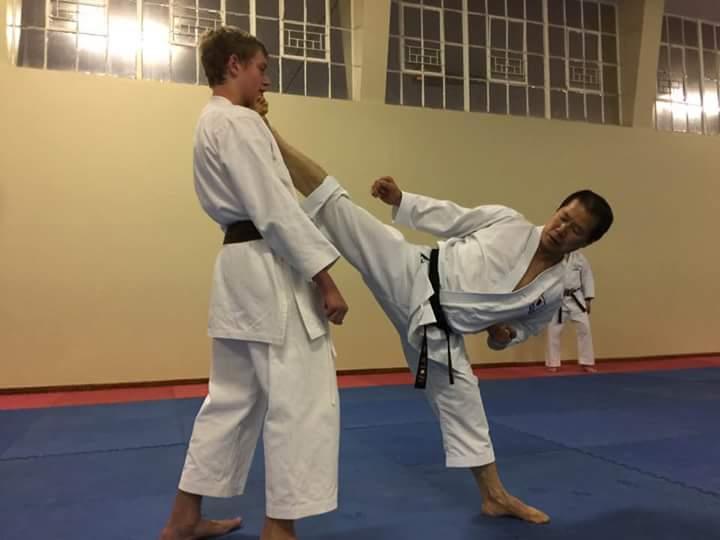
Kagawa Shihan demonstrating the yoko geri, Pretoria
Kagawa Masao Shuseki Shihan of the JKS Honbu Dojo in Japan and former technical director of the World Karate Federation visited four cities in South Africa in September this year. Karateka of all styles and nearly all corners of the country gathered to learn from the best. His knowledge is in great demand throughout the world of all karate styles, this is evident in his busy traveling schedule. He is a living legend and it was a true honour to have him in South Africa. Andre Kok Shihan shares the details of the tour, the focus of his classes and some insights to the karate world beyond what we know.
The purpose of the tour was to grant first hand exposure to South African karateka of all styles in order to boost the overall level of karate.
A tale of four cities
On Tuesday 05 September 2017 Kagawa Shihan arrived in Johannesburg Airport and was met by Norman Robinson Shihan and Andre Kok Shihan who accompanied him on his tour. He was treated to an afternoon at the shooting range, which he thoroughly enjoyed. Before this visit he only enjoyed clay pigeon shooting in Scotland. Later that evening it was a delight to treat him to a proper South African steak before the tour started.

Kagawa Shihan arrives at OR Tambo Int Airport

Kagawa Shihan at the shooting range
Port Elizabeth was first on the list. The classes on Wednesday were well attended and enjoyed by all. On Thursday they flew to Bloemfontein. A highlight for Kagawa Shihan was visiting the Statue of President Nelson Mandela on Naval Hill. It was memorable seeing two of our great leaders side by side.On Friday KSA president, Hanshi Sonny Pillay of SKISA welcomed and escorted them to the Durban Dojo. The students enjoyed the class very much.
Training in Port Elizabeth

Kagawa Shihan at the statue of Nelson Mandela

Yoko geri demonstration in Bloemfontein

Yoko geri demonstration in Durban
The big highlight of the tour for Kagawa Shihan was Saturday’s classes in Pretoria. Besides the great attendance by karateka, legends of karate in South Africa also attended including Malcolm Dorfmann Shihan of KWF, a former KSA president Cass Sehloho Shihan, Nigel Jackson Shihan of SKSA and Soon Pretorius of JSKA. To some it has been decades since they last saw Kagawa Shihan. Malcolm Dorfman, Norman Robinson, Nigel Jackson and Kagawa Shihan shared many years of sweat, blood and tears at the “Hornet’s Nest”, the JKA Honbu Dojo or Hoitsugan in Japan in the 70’s and 80’s. Kagawa Shihan was thrilled at the reunion.
On Sunday evening Arnold de Beer Shihan of the International Shorei Martial Arts Academy celebrated his 50th year in karate in the Gujo Ryu Style. Norman Robinson Shihan, his wife Sally, Andre Kok Shihan, Lourencia Kok Shihan and Kagawa Shihan were guests of honour at this prestigious celebration. The host handed each of the Shihan a plaque of honour for their dedication to the growth of karate in South Africa.
The tour ended with an exciting Sunday visit to the Krugersdorp Rhino and Lion Park. Kagawa Shihan was very impressed with the enormous size of especially the buffalo and rhino. He was in absolute awe of our wildlife. He loved being in our nature and is particularly fond of dogs. He enjoyed playing with Quentin Kyoshi’s Bulldog puppy in Bloemfontein. Kagawa Shihan has a deep respect towards people and a great love for animals, a typical and wonderful characteristic of the Japanese culture.
“Lift your legs”
Kagawa Shihan’s training philosophy is “step by step by step”. Start at the basics and build up to the next level, step by step. The overall focus of the classes was “strong legs make a strong karateka”. The driving force of karate lies within the strength of the legs. He further stressed the importance of not only speed, but timing as well.
In the junior classes he taught mostly that the basis of karate starts with the different stances. Proper stances will lead the way to improved techniques. To the Japanese this was and is still very important. During Kagawa Shihan’s earlier training, Asai Shihan experimented with techniques to improve stances by implementing neko ashi dachi (cat stance) when he formulated the Junro Kata series and many of the “Asai kata” that is still practised all over the world today. The original idea of the” Asai kata” was to improve many of the Shotokan stances and techniques that was not practised in the traditional 26 Kata of Shotokan.

Training in Port Elizabeth
In the senior classes he started his lessons with different stance training - stepping and movement exercises to strengthen the legs. He built upon these exercises adding kicking and different hand techniques. The force in a strike starts as the legs drive into the ground through the hips to the target. With strong legs and proper hip movement the upper as well as lower body techniques will continually improve.

Franco du Plessis, the tallest karateka
Kagawa Shihan lifted many eyebrows with his high kicks to the tallest attending karateka in each region. Franco du Plessis, with a height just short of 2 m was the tallest karateka he met on this tour. As Franco approached, Kagawa Shihan uttered a slight gasp of surprise. But with no effort, he placed toe to chin with his mae geri and toe to ear with his mawashi geri. The karateka loved it. The amazing physical ability of Kagawa Shihan at age 62 stunned and motivated us all. He radiates an energy and enthusiasm that is undeniable and contagious. As he starts a class, he almost effortlessly sets the passion of people on fire.
The legend
Kagawa Masao Shuseki Shihan started karate at age 17 after seeing his brother win the JKA All Japan Championships at the Nippon Budokan of Japan. He recalled that he didn’t know what karate was until he saw his brother win that tournament. That was his trigger and he enthusiastically started training karate the very next day.
His brother was his first teacher and he trained with him until he went to further his studies at Teikyo University. Under the guidance of Abe Sensei, he continued to grow in karate. He completed his studies at Teikyo University and then enrolled in the Kenshusei programme at the JKA Headquarters Japan.
When asked about his training as a kenshusei (learner instructor) at the Honbu dojo he told how karate training at the Honbu Dojo was always very, very tough and he placed emphasis on the fact that karate training in those years was never easy. The term “Hornets’ Nest” was given to the JKA Honbu Dojo by South African Pioneers in karate; Norman Robinson, Stan Schmidt, Eddie Dorey, Nigel Jackson, Ken Whitstock, Robert Ferriere, Malcolm Dorfman. Here in South Africa they entertained their own juniors with stories about their excursions with the Japanese and their training in the infamous “Hornets’ nest”.
Kagawa Shihan trained with Nakayama Shihan, the former head of JKA. Although Nakayama Shihan taught once a week at the instructor class, Kagawa Shihan was mostly taught by Asai Shihan and some of the other seniors like Tanaka, Ueki and Abe Sensei’s. Interestingly whenever Nakayama Shihan presented classes, he never actually spoke to Kagawa Shihan personally. Kagawa Shihan found it strange that all his senpai was generally corrected or motivated by Nakayama Shihan, yet he can only remember once how he was corrected by Nakayama Shihan on his “Hikite”, and only by mere gesture. Although this attitude would surprise and confuse us South Africans, Kagawa Shihan went on with the conversation as if that was perfectly fine and that it was just how it was. This is an example of the difference between South African and Japanese culture.
After questioning Kagawa Shihan about his reference to Abe Sensei, Yano Sensei, Tanaka Sensei etc. as his Senpai he took some time to explain the expressions “Senpai”, “Kohai” and “Dohai”. In the Kenshusei system of the Honbu Dojo anyone who started or completed the programme before you would be your “Senpai” and you would be his junior or “Kohai”. If someone started the programme more or less the same time with you, you would call each other “Dohai”.
When asked how he managed to acquire his great karate skill he said it is very important to always look closely at others and see how they do techniques. Our biggest assets in learning karate are the eyes because you can closely study how to properly perform a technique before attempting to do it yourself.

Leg training in Pretoria

Leg training in Port Elizabeth
When asked about his incredible kicking ability he said he wasn’t born supple. When he was young he realised he should work hard on strengthening his legs and kicking ability. He would always stay longer after classes to work on his kicking and suppleness. Through years of flexibility training and forcing his joints to loosen more, he eventually reached a very high level of suppleness and strength that we see today. Andre Shihan asked him whether he suffered from any joint pain or injuries sustained through all the years of intense training. With a big smile on his face, he answered: “Of course Andre! Every day pain, always pain, when training very hard one must feel pain”. He also admitted that he doesn’t have any physical problems and is lucky to never have suffered any serious injury.
With the 2020 Olympics coming up and karate being an official Olympic Sport, Kagawa Shihan expressed his enthusiasm and excitement saying many people in Japan see karate differently now and are looking forward to karate being showcased during the Olympics. The fact that Japan can also do very well in 2020 has more athletes training more seriously with the hope of being included in the Japanese team for 2020.
What karate is really about
A misconception is that sport karate features as a high priority in Kagawa Shihan’s teaching, but he advocates traditional karate first, competition or sport karate second. He teaches karate as an art and lifestyle above all else.
He went on by saying his team at Teikyo University always start their training with kihon, kata and basic forms of kumite. This kind of training strengthens the mind and also the body. In Japan karate is typically practised at school and University level. Competition karate usually lasts a limited time for his students. It tends to lose priority when they finish their studies and start their careers. Some athletes are very good in competition karate, but they are just that. According to Kagawa Shihan the difference between a karate athlete and a traditional karateka lies in the heart. The traditional karateka doesn’t retire, but tends to stay in the lifestyle of regular karate training.
On many occasions Kagawa Shihan complimented the South African hospitality and our love for braai and socialising around a fire. It was a perfect time of the year to visit South Africa just as spring came into bloom. South Africa is grateful to the organisers of the tour and Kagawa Shihan who inspired us with his amazing knowledge and ability.
 Group photo taken in Pretoria along with some of the great legends of SA karate
Group photo taken in Pretoria along with some of the great legends of SA karate























